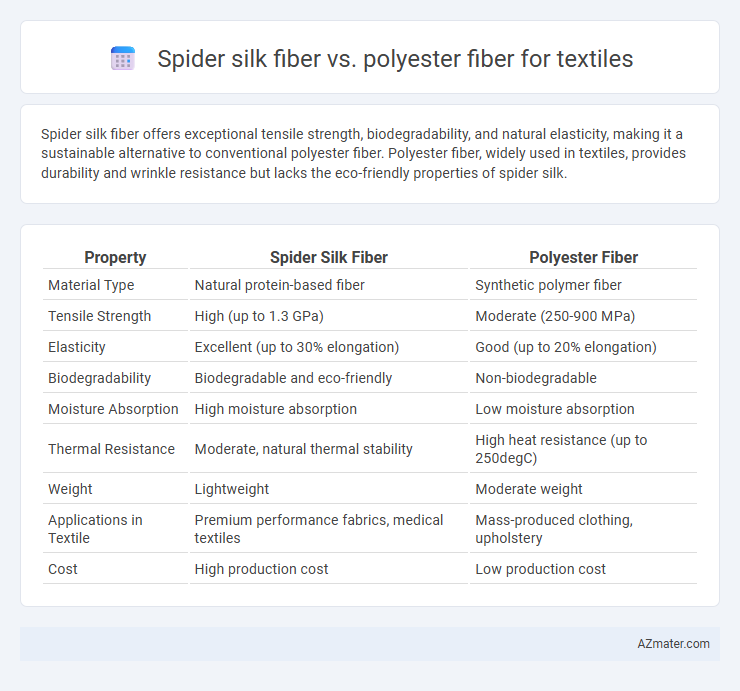Spider silk fiber offers exceptional tensile strength, biodegradability, and natural elasticity, making it a sustainable alternative to conventional polyester fiber. Polyester fiber, widely used in textiles, provides durability and wrinkle resistance but lacks the eco-friendly properties of spider silk.
Table of Comparison
| Property | Spider Silk Fiber | Polyester Fiber |
|---|---|---|
| Material Type | Natural protein-based fiber | Synthetic polymer fiber |
| Tensile Strength | High (up to 1.3 GPa) | Moderate (250-900 MPa) |
| Elasticity | Excellent (up to 30% elongation) | Good (up to 20% elongation) |
| Biodegradability | Biodegradable and eco-friendly | Non-biodegradable |
| Moisture Absorption | High moisture absorption | Low moisture absorption |
| Thermal Resistance | Moderate, natural thermal stability | High heat resistance (up to 250degC) |
| Weight | Lightweight | Moderate weight |
| Applications in Textile | Premium performance fabrics, medical textiles | Mass-produced clothing, upholstery |
| Cost | High production cost | Low production cost |
Introduction to Spider Silk and Polyester Fibers
Spider silk fiber, renowned for its exceptional tensile strength and elasticity, is a natural protein fiber produced by spiders used in advanced textile applications for lightweight, durable, and biodegradable fabrics. Polyester fiber, a synthetic polymer derived from petroleum, dominates the textile industry with its high durability, wrinkle resistance, and cost-effectiveness, making it ideal for mass production of clothing and upholstery. The unique molecular structure of spider silk enables superior mechanical properties, while polyester's thermoplastic characteristics allow for versatile manufacturing techniques.
Origins and Production Methods
Spider silk fiber originates from the natural secretion of spiders, harvested through a labor-intensive process involving the careful collection of silk strands from silk-producing spider species. Polyester fiber is a synthetic material created via a chemical reaction called polymerization, typically using petroleum-based raw materials such as purified terephthalic acid (PTA) and monoethylene glycol (MEG). The production of spider silk focuses on biological extraction or bio-engineering methods using genetically modified organisms, whereas polyester relies on large-scale industrial manufacturing involving melt spinning and extrusion techniques.
Molecular Structure Comparison
Spider silk fiber exhibits a hierarchical molecular structure composed primarily of repetitive protein sequences with high b-sheet crystallinity, providing exceptional tensile strength and elasticity. Polyester fiber, made from synthetic polymers like polyethylene terephthalate (PET), has a more uniform, linear molecular chain with strong covalent bonds but limited natural elasticity. The unique arrangement of amino acid sequences in spider silk allows dynamic molecular deformation and energy absorption, surpassing polyester's mechanical performance in textile applications.
Mechanical Strength and Durability
Spider silk fiber exhibits exceptional mechanical strength with tensile strength reaching up to 1.3 GPa, surpassing most polyester fibers that typically range between 0.2 to 0.9 GPa. Its unique protein-based structure provides superior elasticity and toughness, enabling it to withstand repeated stress and deformation without significant wear. Polyester fiber, while durable and resistant to environmental factors like moisture and UV radiation, tends to degrade faster under mechanical fatigue compared to the highly resilient and biodegradable spider silk.
Flexibility and Elasticity Analysis
Spider silk fiber exhibits superior flexibility compared to polyester fiber, allowing it to bend and stretch without breaking due to its unique protein structure with repeated beta-sheet crystals. The elasticity of spider silk surpasses polyester, as it can stretch up to 30% of its original length while retaining remarkable tensile strength, making it ideal for high-performance textile applications. In contrast, polyester fiber offers moderate elasticity, typically stretching only 10-15%, and tends to recover its shape less efficiently after deformation, limiting its use in flexible and stretchable fabrics.
Environmental Impact and Sustainability
Spider silk fiber outperforms polyester fiber in environmental impact due to its biodegradability and renewable production process, relying on natural protein synthesis without harmful chemicals. Polyester fiber, derived from petroleum, contributes significantly to carbon emissions and microplastic pollution, posing challenges for sustainability in textile manufacturing. Emphasizing spider silk enhances eco-friendly textile solutions by reducing synthetic waste and conserving finite fossil fuel resources.
Comfort and Wearability Factors
Spider silk fiber offers superior breathability and moisture-wicking properties compared to polyester fiber, enhancing comfort during prolonged wear. Its natural elasticity and softness reduce skin irritation and improve overall wearability, making garments lightweight and flexible. Polyester fiber, while durable and wrinkle-resistant, tends to trap heat and moisture, which may cause discomfort in active or warm conditions.
Dyeability and Aesthetic Appeal
Spider silk fiber exhibits superior dyeability compared to polyester fiber due to its natural protein structure, allowing it to absorb colors more vividly and uniformly. The aesthetic appeal of spider silk is enhanced by its lustrous sheen and smooth texture, which creates a luxurious and elegant finish in textiles. Polyester fiber, being synthetic, often requires chemical treatments for dye uptake and typically presents a less natural sheen and feel, resulting in a less refined appearance.
Cost and Scalability in Textile Manufacturing
Spider silk fiber offers exceptional strength-to-weight ratio and biodegradability but faces high production costs and limited scalability due to complex harvesting and synthesis processes. Polyester fiber, in contrast, is highly cost-effective and scalable, benefiting from established petroleum-based manufacturing infrastructure and continuous mass production capabilities. Textile manufacturers favor polyester for large-scale applications where budget and volume are critical, while spider silk remains niche for premium, sustainable textile innovations.
Future Trends and Innovations in Fiber Technology
Spider silk fiber exhibits remarkable strength, elasticity, and biodegradability, positioning it as a sustainable alternative to conventional polyester fiber in textile manufacturing. Advances in bioengineering and synthetic biology are enabling mass production of recombinant spider silk, enhancing its scalability and cost-effectiveness. Emerging innovations in fiber blending and nanotechnology integration aim to create hybrid fabrics that combine spider silk's natural performance with polyester's durability and moisture-wicking properties, shaping the future of high-performance, eco-friendly textiles.

Infographic: Spider silk fiber vs Polyester fiber for Textile
 azmater.com
azmater.com